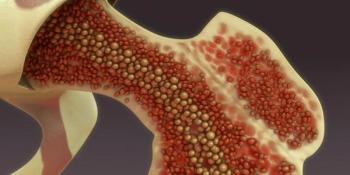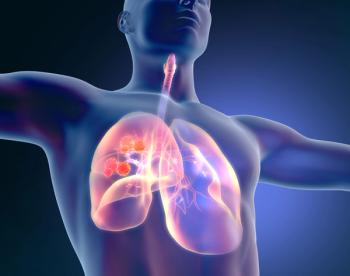
Data Show Enduring Responses With Talquetamab Combo in R/R Multiple Myeloma
Findings from the phase 1b TRIMM-3 trial support the potential activity of PD-1 inhibition in patients with relapsed/refractory multiple myeloma.
Proof-of-concept findings from the phase 1b TRIMM-3 trial (NCT05338775) showed enduring responses in patients with relapsed/refractory multiple myeloma who received talquetamab-tgvs (Talvey) plus cetrelimab, according to a presentation at the
Findings showed that, at a medium follow-up of 11.5 months (range, 1.5-32.3), the objective response rate (ORR) with the combination in the overall population (n = 44) was 70.5%, with a very good partial response (VGPR) or higher rate of in 65.9%; the complete response (CR) rate was 6.8%, the VGPR rate was 25.0%, and the partial response (PR) rate was 4.5%.
The median time to first response was 1.9 months (range, 0.8-17.5), the median time to best response was 4.0 months (1.1-22.8), and the median duration of response (DOR) was 16.8 months (range, 10.6-not estimable [NE]). The 9-month duration of response (DOR) and 6-month progression-free survival (PFS) rates were 72.6% and 69.9%, respectively.
“These data support talquetamab as a versatile combination partner and suggest potential activity of PD-1 inhibitors in relapsed/refractory multiple myeloma,” lead study author Aurore Perrot, MD, PhD, an associate professor in hematology of Centre Hospitalier Universitaire de Toulouse in Toulouse, France, said in an oral presentation of the data.
In August 2023, talquetamab, a GPRC5D-targeting bispecific antibody, was granted accelerated approval by the FDA for the treatment of adult patients with relapsed/refractory multiple myeloma who have received at least 4 prior lines of therapy, including a proteasome inhibitor, an immunomodulatory agent, and an anti-CD38 antibody.
Cetrelimab is a PD-1 antibody that, when combined with talquetamab, could lead to synergistic anti-myeloma effects by reinvigorating T cells, in this patient population, including those with heavily pretreated disease, investigators theorized.
The multicenter, open-label, phase 1b TRIMM-3 study had both dose-escalation and expansion cohorts of patients with relapsed/refractory multiple myeloma. Cohorts comprised subcutaneous talquetamab at 0.4 mg/kg or 0.8 mg/kg every 2 weeks plus cetrelimab intravenously at 80 mg, 160 mg, or 240 mg every 2 weeks starting in day 2, cycle 2 (n = 25); the dose-expansion cohort included talquetamab at 0.8 mg/kg every 2 weeks plus cetrelimab at 240 mg every 2 weeks, also starting on day 2 of cycle 2 (n = 19). All patients in the dose-expansion cohort had prior exposure to a bispecific antibody.
Perrot noted that the talquetamab and cetrelimab dosing regimens were escalated to their respective recommended phase 2 doses, which were 0.8 mg/kg every 2 weeks and 240 mg every 2 weeks, respectively.
To be eligible for enrollment, patients with relapsed/refractory multiple myeloma could not be eligible for or expected to benefit from other available treatments and had to have an ECOG performance status of 0 or 1.
The primary end point was safety; secondary outcome measures were ORR, DOR, time to response, and pharmacokinetics.
As of April 2, 2025, 44 patients were treated with the combination of talquetamab and cetrelimab. The median age was 64 years (range, 45-87), 54.5% were male, half were White, and 43.6% had high-risk cytogenetics. Patients either had International Staging System stage I (61.4%), II (25.0%), or III disease (13.6%). The median number of prior lines of therapies was 5 (range, 2-11), all patients had received triplet regimens, 65.9% received quadruplets, and 70.5% had prior BCMA-directed therapy. Fifty percent of all patients previously received a bispecific antibody, and most patients were triple-class refractory (84.1%).
Additional efficacy data showed that, in the dose-expansion cohort of patients who previously received bispecific antibody treatment (n = 19), the ORR was 68.4%, and the VGPR rate or higher was 63.2%; the stringent CR rate was 31.6%, the VGPR rate was 31.6%, 5.3%. Here, the median time to first response was 1.9 months (range, 0.8-3.7), and the median time to best response was 3.7 months (range, 1.8-7.4). The median DOR was 12.0 months (range, 8.9-NE). The 9-month DOR rate was 65.9%, and the 6-month PFS rate was 61.5%.
Perrot noted that in the dose-expansion cohort, all but 1 patient had received a BCMA-targeted bispecific antibody, and 95% of patients with prior bispecific therapy received it as their immediate prior line of therapy. There was a median of 39 days since prior exposure to the treatment, she added.
Regarding safety, the most common adverse effects (AEs) included changes in taste (any-grade, 81.8%), nail (75.0%), non-rash skin (70.5%), and infections (81.8%; grade 3/4, 29.5%), dry mouth (47.7%), decreased weight (34.1%; 2.3%), diarrhea (31.8%; 2.3%), rash (31.8%; 2.3%), PD-1 immune–mediated events linked with cetrelimab (29.5%; 6.8%), and pyrexia (2.5%).
GPRC5D-related AEs were mostly low grade with no treatment discontinuations, Perrot noted; 14% of patients overall had AEs that led to discontinuation of therapy. Twenty percent of patients had dose reductions due to talquetamab-related AEs.
Cytokine release syndrome (CRS) occurred in 61.4% of patients and was all grade 1/2, with Perrot adding that it was mostly confined to step-up and cycle 1 dosing prior to cetrelimab dosing. The median time to CRS onset was 2 days (range, 1-11), and the median duration of CRS was also 2 days (range, 1-7). Most patients received supportive measures (54.5%) with tocilizumab (Actemra; 34.1%), followed by corticosteroids (2.3%), and other (43.2%).
Immune effector cell-associated neurotoxicity syndrome was reported in 2 patients, and both cases were grade 1 in severity.
Grade 3/4 infections were comparable with single-agent talquetamab data from the phase 1/2 MonumenTAL-1 trial (NCT03399799; NCT04634552).3 Infections of this severity on TRIMM-3 included COVID-19 (2.3%), nasopharyngitis (2.3%), and pneumonia (4.5%). Grade 3/4 hematologic AEs comprised anemia (38.6%), neutropenia (43.2%), thrombocytopenia (15.9%), leukopenia (9.1%), and lymphopenia (27.3%).
Hypogammaglobulinemia was reported in 56.8% of patients, and 34.1% were treated with intravenous immunoglobulin. There was 1 death, which was due to pneumonia.
No reduction in B-cell counts was observed overall, and in patients who previously received a CD3-redirecting antibody, there were higher rates of T-cell recovery and costimulatory molecule expression in CD8 T cells in cycle 3 vs cycle 2. There was also greater T-cell reinvigoration potential in those who had previously received a bispecific antibody.
Disclosures: Perrot cited affiliations with Abbvie, Adaptive, Amgen, Bristol Myers Squibb, GSK, JnJ, Pfizer, Sanofi, and Takeda.
References
- Perrot A, Touzeau C, Rodríguez-Otero P, et al. Talquetamab + cetrelimab in patients with relapsed/refractory multiple myeloma: initial safety and efficacy results from the phase 1b TRIMM-3 study. Presented at: European Hematology Association 2025 Congress; June 12-15, 2025; Milan, Italy. Abstract S200.
- U.S. FDA approves Talvey (talquetamab-tgvs), a first-in-class bispecific therapy for the treatment of patients with heavily pretreated multiple myeloma. News release. Janssen. August 10, 2023. Accessed August 10, 2023. https://www.janssen.com/us-fda-approves-talveytm-talquetamab-tgvs-first-class-bispecific-therapy-treatment-patients-heavily
- Chari A, Minnema MC, Berdeja JG, et al. Talquetamab, a T-cell–redirecting GPRC5D bispecific antibody for multiple myeloma. N Eng J Med. 2022;387(24):2232-2244. doi:10.1056/NEJMoa220459
Newsletter
Stay up to date on recent advances in the multidisciplinary approach to cancer.























































































